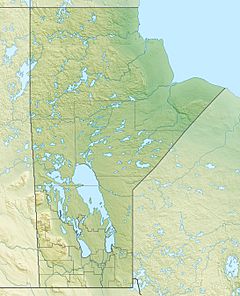Sturgeon River (Manitoba) facts for kids
Quick facts for kids Sturgeon River |
|
|---|---|
|
Location of the mouth of the Sturgeon River in Manitoba
|
|
| Country | Canada |
| Provinces | |
| Physical characteristics | |
| Main source | Unorganized Kenora District, Northwestern Ontario 119 m (390 ft) 55°25′42″N 90°02′09″W / 55.42833°N 90.03583°W |
| River mouth | Echoing River Northern Region, Manitoba 86 m (282 ft) 55°31′20″N 91°22′43″W / 55.52222°N 91.37861°W |
| Length | 105 km (65 mi) |
| Basin features | |
| River system | Hudson Bay drainage basin |
| Tributaries |
|
The Sturgeon River is a cool river that flows through two Canadian provinces: Manitoba and Ontario. It's part of a huge water system that eventually leads to Hudson Bay. This river is about 105 kilometers (65 miles) long, which is like traveling the distance of about 1,050 football fields!
The river starts its journey in a wild, undeveloped area called Unorganized Kenora District in northwestern Ontario. From there, it flows west, passing through a lake also named Sturgeon Lake. Along its way, another river called the Hayhurst River joins it. Finally, the Sturgeon River empties into the Echoing River in northern Manitoba. The Echoing River then connects to the Gods River and the Hayes River, which both flow into Hudson Bay.
Contents
What is a Drainage Basin?
A drainage basin is like a giant funnel for water. It's an area of land where all the rain and snowmelt drain into one main river or lake. The Sturgeon River is part of the massive Hudson Bay drainage basin. This means all the water from the Sturgeon River's path eventually ends up in Hudson Bay.
Why are Drainage Basins Important?
Drainage basins are super important for many reasons. They help us understand how water moves across the land. They also show us how different rivers and lakes are connected. Protecting a drainage basin helps keep the water clean for everyone. This includes people, animals, and plants that live nearby.
Where Does the Sturgeon River Start and End?
The Sturgeon River begins in a place called Unorganized Kenora District in Northwestern Ontario. This area is mostly wilderness. The river's starting point is about 119 meters (390 feet) above sea level. Imagine standing on top of a 39-story building!
The River's Journey to Hudson Bay
As the Sturgeon River flows, it travels west. It passes through Sturgeon Lake, which is a natural part of its path. Just before it reaches its end, it gets a boost from the Hayhurst River. The Hayhurst River is a "right tributary," meaning it joins the Sturgeon River from the right side if you're looking downstream.
The Sturgeon River's journey ends when it flows into the Echoing River. This happens in the Northern Region of Manitoba. From there, the water continues its long trip through the Gods River and the Hayes River. Finally, it reaches the vast waters of Hudson Bay. The mouth of the Sturgeon River is about 86 meters (282 feet) above sea level.
Wildlife Around the Sturgeon River
Rivers like the Sturgeon River are home to many different kinds of wildlife. While we don't have specific details about this river's animals, rivers in this region often support a variety of creatures.
Fish and Other Water Animals
Many types of fish live in these cold, clear waters. You might find pike, walleye, and, of course, sturgeon! Sturgeon are very old and large fish. They can live for many years. Other animals like beavers and otters also make their homes along riverbanks. They are often seen swimming and playing in the water.
Birds and Land Animals
The forests and wetlands around the Sturgeon River are perfect for birds. You might spot bald eagles soaring overhead or osprey diving for fish. Ducks and geese often nest near the water. On land, animals like moose, deer, and bears might visit the river to drink. The river provides a vital water source for all these creatures.
Why is the Sturgeon River Important?
The Sturgeon River, like many rivers, plays a big role in its environment. It provides water for plants and animals. It also helps shape the land as it flows.
Connecting Communities and Nature
Even though the Sturgeon River flows through mostly unorganized areas, it's still important. It connects different parts of the landscape. It also forms a natural pathway for wildlife. For people, rivers like this can be used for things like canoeing or fishing, offering a chance to explore nature.


